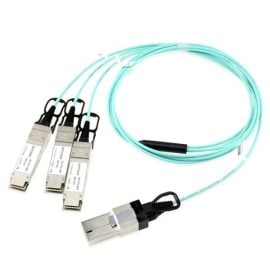Network Cabling
What is Data Center Interconnect (DCI): Definition, Technology, Application
Data centers are becoming increasingly important in the Web 3.0 value connectivity era. Businesses and consumers’ growing digital lives rely on data centers to store and process information services, cloud services, and application data content. Data centers are the backbone of digital networks by providing storage and computational resources for information services, cloud services, and application data content. Data center networks support a wide range of activities from day-to-day office work to gaming and entertainment, while individual data centers are straining under their weight.
Because data centers are no longer “islands” to exchange or backup data and conduct load balancing, they must be networked. According to market research studies, the worldwide data center interconnection sector is expected to grow at a CAGR of 14% from 2021 through 2026, making data center interconnect (DCI) a trend.
Table of Contents
- What is data center interconnect (DCI)?
- Data center interconnect technologies
- Data center interconnect applications
- Conclusion
What is data center interconnect (DCI)?
Data Center Interconnect (DCI) is the process of networking data centers to enable the exchange of traffic between them. DCI provides a high-bandwidth, low-latency connection that ensures data is transferred quickly and securely between data centers. DCI solutions allow data center operators to extend their networks to multiple locations, providing redundancy and resilience in an outage.
The Data Center Interconnect can be divided into two types:
By DCI transmission distance:
- Short distance: within 5km, typically employing integrated cabling to connect campus data centers.
- Medium distance: within 80km, often refers to linkage through optical modules in neighboring cities or medium geographic areas.
- Long distance: hundreds of kilometers, referring to long-distance data center interconnection using optical transmission equipment such as undersea fiber optic cable networks.
By DCI internet connection:
- Network Layer 3 interconnect: Front-end networks in different data centers connect via IP networks, allowing for the recovery of data that has been replicated to the standby site when the primary data center site fails, as well as the ability to restart applications within a short window of disruption, while also protecting this traffic from malicious network attacks and making it always available.
- Network Layer 2 Interconnect: Building a large Layer 2 network (VLAN) across data centers, primarily to satisfy the server cluster’s virtual dynamic migration requirements, necessitates the concerns listed below.
- Low latency: The purpose of Layer 2 interconnection between data centers is to enable off-site scheduling of virtual machines and off-site application of clusters; nevertheless, the latency requirements for off-site access to virtual machines and cluster storage must be satisfied.
- High bandwidth: One of the primary requirements of data center interconnection is the transfer of virtual machines across data centers, which places a premium on bandwidth.
- High availability: Creating backup connections to support business continuity is one of the most effective strategies to boost availability.
- Storage network interconnect: using transmission technologies, data replication of disk arrays between primary and disaster recovery centers (bare fiber, DWDM, SDH, etc.).
Data center interconnect technologies
Multiprotocol Label Switching (MPLS)
The MPLS technology-based interconnection solution necessitates the use of the MPLS technology core network to connect data centers, allowing you to go straight from VLL and VPLS to finish the data center direct Layer 2 interconnection. Wide area network deployment, which has been completed in various industries but is challenging to execute and maintain because of its underlying technological intricacy, has been completed.
VXLAN-DCI Tunneling
VXLAN technology is utilized to achieve Layer 2/3 connectivity of many data center networks. VXLAN networking is flexible and controllable, with security isolation and centralized control features, making it suitable for future scenarios of connecting multiple data centers. This conclusion was reached based on the current level of technical maturity and commercial case experience.
IP Tunnel
The IP tunnel technology is a packet encapsulation type that enables the connectivity of heterogeneous networks at Layer 2 across various data centers.
-
 120G CXP to 3x 40G QSFP+ Breakout AOC (Active Optical Cable)
120G CXP to 3x 40G QSFP+ Breakout AOC (Active Optical Cable) -
 120G CXP AOC (Active Optical Cable)
120G CXP AOC (Active Optical Cable) -
 Fortinet SP-CABLE-FS-SFP28 Compatible 25G SFP28 Passive DAC Cable
Fortinet SP-CABLE-FS-SFP28 Compatible 25G SFP28 Passive DAC Cable -
 OPTCORE 400G QSFP-DD AOC Cable, Generic QSFPDD-400G-AOC Compatible
OPTCORE 400G QSFP-DD AOC Cable, Generic QSFPDD-400G-AOC Compatible -
 Cisco SFP-H10GB-CU1M Compatible 10G SFP+ 1m DAC CableOriginal price was: US$ 6.20.US$ 6.00Current price is: US$ 6.00. (Excl. VAT)
Cisco SFP-H10GB-CU1M Compatible 10G SFP+ 1m DAC CableOriginal price was: US$ 6.20.US$ 6.00Current price is: US$ 6.00. (Excl. VAT) -
 10G SFP+ 1m DAC Cable,Compatible with ZYX DAC10G-1MUS$ 6.20 (Excl. VAT)
10G SFP+ 1m DAC Cable,Compatible with ZYX DAC10G-1MUS$ 6.20 (Excl. VAT)
Data center interconnect applications
Hyperscale Data Center Connectivity

Hyperscale data center connectivity necessitates low-latency and high-bandwidth DCI solutions to satisfy the performance requirements of these demanding applications. DCI solutions for hyperscale data center connectivity should also offer high availability features to ensure that applications are always available.
Finance and Securities

Data center interconnection is critical for financial services companies because it allows them to connect their data centers to trade with each other in real-time. DCI solutions for finance and securities companies should offer low latency and high bandwidth to meet these applications’ demanding requirements. In addition, DCI solutions for finance and securities companies should also provide high availability features to ensure that applications are always available.
Government and Public Sector

Data center interconnection is critical for government and public sector organizations because it allows them to connect their data centers to share information and resources in real-time. DCI solutions for the government and public sector organizations should offer low latency and high bandwidth to support the exchange of large amounts of data. In addition, DCI solutions should be highly secure and compliant with government regulations.
Conclusion
Data center interconnect is a crucial enabler for many applications and services. DCI solutions should offer high bandwidth and low latency to meet the demands of these applications. In addition, DCI solutions should also provide high availability features to ensure that applications are always available. When choosing a DCI solution, it is essential to consider your organization’s specific needs.
Optcore provides a total transceiver solution for data center interconnect applications. Our portfolio of DCI-optimized transceivers offers low power consumption, high port density, and plug-and-play installation. With data rates ranging from 10G to 100G, our transceivers are designed for use in various DCI applications.
Read more:
- Top 4 Optcore DAC Cable for Data Center Interconnect (DCI) Networks -2022
- Tips on Choosing Right Transceivers to Save Data Center Cost
- Understanding PAM4 Signaling: A Beginner Guide







